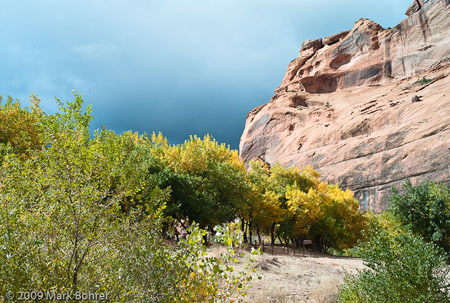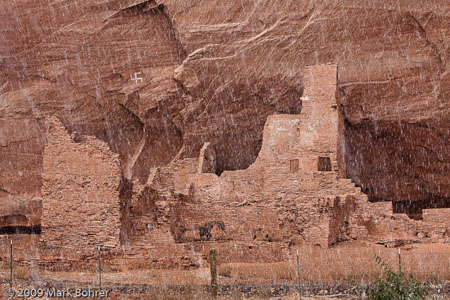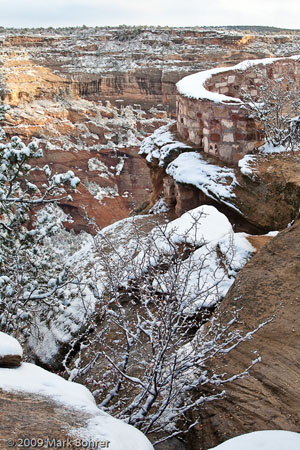You can deal with storms, right?
I mean, you’re pre-shrunk, aren’t you? Besides, clouds make for more interesting skies.

Our Navajo guide Oscar Bia probably thought I was just a crazy billegana (white person) when I asked him to remove the roof of his jeep before our tour of Canyon de Chelly. Storm clouds had already moved in, and it was cold enough to expect snow.
But I knew there’d be opportunities to use his jeep as a frame for pictures, and there’d be things I wouldn’t see with the roof on. So I loaded myself and camera gear in the back, and put my wife Pat in front where there was some heat from the jeep.
My intuition was right, though it got pretty cold back there. Angry gray skies made the brick-orange sandstone and yellow cottonwood leaves really pop. Falling snow streaked in front of often-photographed White House Ruin, and gave the pictures a very different feel. After too many years living in California, I went nuts over fresh snow.

Fingertipless wool gloves are a must-have when I photograph in cold weather, and they came in handy this time. I just wish I’d worn longjohns under my jeans.
The only sour moment came after the tour, from an over-zealous rock art vendor at Antelope Ruin Overlook. This gentleman was so intent on trying to establish rapport and get me looking at his hand-carved petroglyphs that we decided to hop back in the car and drive to Mummy Cave Overlook to get away. Sometimes it’s not worth the time to explain that you’re there to capture photographs, not souvenirs.
Mummy Cave Overlook’s snow-shrouded trees and late afternoon light on rock faces made the best photographs. The ruin itself was interesting for its square tower kiva, but I wished for clearer air and a longer lens to shoot it.
A few minutes after sunset, we were only too happy to get back in the car and drive to Garcia’s Restaurant for hot Navajo Stew and enchiladas. We knew we’d captured some one-of-a-kind images, making it worth being cold.
Besides, where else can you see Kokopelli playing the flute on his back?

Contact Oscar Bia’s Spider Rock Jeep Tours at (928) 349-5912.
Shot Notes –
A 70-200mm f/2.8 lens will serve you well on tours in the Canyon. You’ll also want something in the 35mm-75mm range for sweeping scenics. I avoid having them look like everyone else’s postcards by photographing late in the day or during a storm. Winter photography extends the so-called ‘magic hours’ at sunrise and sunset, since you get low-angle sun for most of the day.
I used an EOS 5D mark II with the 70-200mm zoom, and a Leica M8 with 35mm f/2 Summicron-M ASPH for wider coverage. Because of wind and snow, I didn’t even think of changing lenses in the Canyon. I did use a 50mm Summilux on the M8 at Mummy Cave Overlook when I could swap lenses inside a closed car. With digital, cleanliness is next to Godliness – and it means a lot less time de-spotting pictures in Lightroom or Photoshop.
Archeological notes –
Canyon de Chelly has seen farmers and hunter-gatherers from pre-Basketmaker times to Anasazi Pueblo I-IV to modern Navajo and Hopi. All cliff ruins date from Pueblo III. White House Ruin was first constructed around 1060, with additions and remodeling as late as 1275. The Anasazi abandoned all pueblos in the Canyon by 1300.
Navajos hid from Kit Carson in the Canyon when he was rounding them up for the Long Walk to Bosque Redondo in 1864.
Modern Navajo still farm Canyon de Chelly in summers today.

Those photos – really miss New Mexico– especially of the summer rain. Rain here in Cape Town is always gray, drippy and overcast– I miss those big New Mexico thunderstorms where you can still see blue sky in the distance. -X